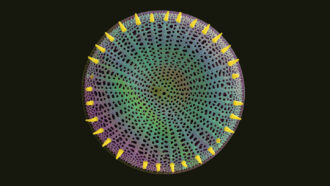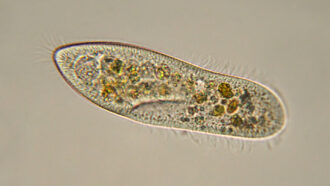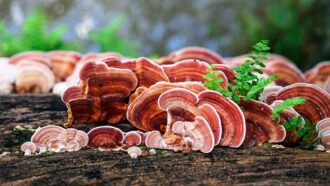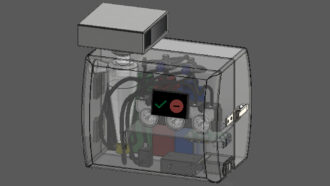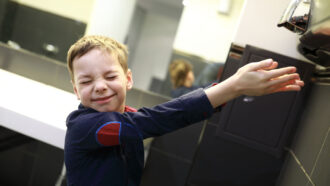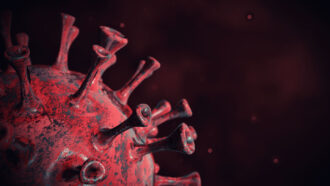The bugs within us
Hordes of bacteria live inside animals, affecting their health, food choices and mating
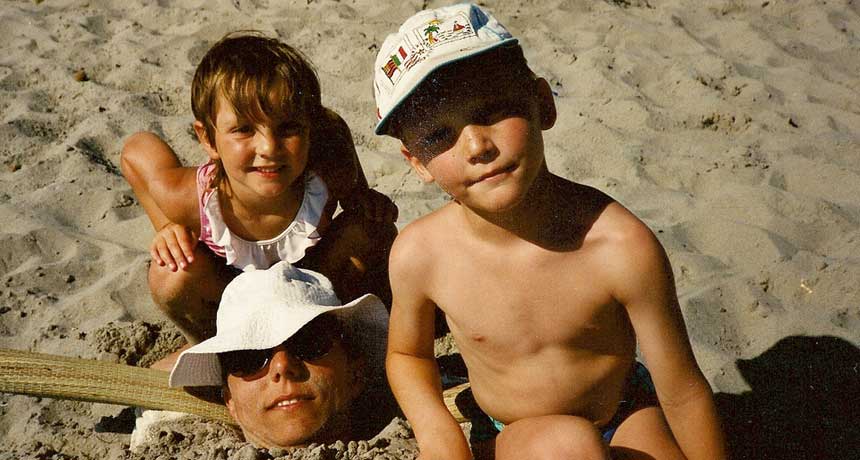
What you see here are three people enjoying their day at the beach. What you don’t see are the many, many microbes that are an integral part of their bodies. Indeed, in terms of the numbers of cells present, we are all more bacterial than human.
Gareth Williams / Flickr (CC BY 2.0)
By Roberta Kwok
You are full of bugs.
No, not cockroaches and ants. These bugs are tiny, single-celled bacteria you can’t see. They blanket your skin. They also fill your stomach, intestines, lungs and mouth.
In fact, roughly 100 trillion of these microscopic critters live in (and on) the human body. A typical person contains only about 37 trillion human cells. In other words, bacteria might outnumber human cells in an average person by roughly three to one.
Don’t worry about being less than human, though. Bacterial cells are very small. All of these bugs make up only between 1 and 3 percent of your body weight.
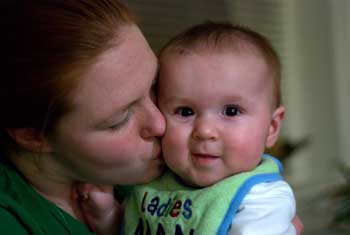
At this point, you might be starting to wish you could get rid of all those germs. But that wouldn’t be a very good idea. The microbes in your body are crucial to your health. They churn out nourishing vitamins. They help digest your food. Some even keep other, dangerous bacteria from multiplying so you don’t get sick.
In return, the bacteria get nutrients and a place to live. “It’s a tit for tat,” says Margaret McFall-Ngai. She is a microbiologist at the University of Wisconsin-Madison.
Other microbes, such as viruses and fungi, also occupy our bodies. Scientists call the entirety of the microbes in a human or other animal its microbiome (MY-kro-BY-ohm). The more scientists have been learning about the microbiome, the more they have come to appreciate its importance.
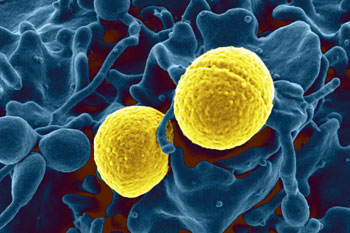
A leak in the brain
One of our most critical body parts is, of course, the brain. And, it turns out, bacteria may help our brains develop properly.
Viorica Braniste is a researcher at the Karolinska Institute in Stockholm, Sweden. She studies how animals’ bodies function. Braniste and her colleagues investigated a part of the body called the blood-brain barrier.
This barrier is made of several types of cells. Some form the walls of blood vessels in the brain. Other cells wrap around those blood vessels. This barrier allows helpful nutrients to pass from the blood to brain cells. It also blocks harmful substances from entering our brain.
Braniste and her colleagues wondered if an animal’s gut microbes could strengthen the blood-brain barrier. Scientists already knew that intestinal bacteria could influence behavior. (Behavior is how an organism conducts itself, which is governed by the brain.) Perhaps the bacteria produced chemicals that entered the blood, travelled to the brain and affected development of the blood-brain barrier.
To find out, the researchers raised mice in a sterile environment. These mice lacked bacteria. Then the team compared blood-brain barriers in the sterile animals to those of normal, germy mice.

In another test, the researchers injected the mice with a protein that harms brain cells. The brain cells of normal mice seemed unaffected, suggesting the protein had stayed in the blood. But in bacteria-free mice, some of the animals’ brain cells died. That suggested the harmful protein had breached the blood-brain barrier.
Braniste and her colleagues then tried to repair the leaky barriers. The scientists fed bacteria from normal mice to the sterile animals. After two weeks, the rodents’ blood-brain barriers became tightly sealed. The researchers published their results in the journal Science Translational Medicine in November 2014.
The results suggest that mice need their gut microbes to develop a healthy blood-brain barrier. And it’s possible the same is true in people.
If it is, then it might be particularly important to preserve those microbes in babies who are born too early. Such infants don’t have fully developed blood-brain barriers when they’re born.
Doctors often give these babies antibiotics to ward off possible infections in the hospital. Antibiotics are chemicals that kill harmful bacteria — but they also kill good gut bacteria. These medicines might kill the good bacteria right when babies need those microbes to strengthen their immature blood-brain barrier. While it’s important to treat infections, says Braniste, doctors should avoid overusing antibiotics.
What’s for dinner?
Bacteria do more than aid normal development. In some species, microbes also appear to lead animals to safe sources of nutritious food.
Reuven Dukas has studied bacteria in fruit flies. Dukas is a biologist at Canada’s McMaster University in Hamilton, Ontario. His team has investigated how microbes influence which food a fly chooses to eat.
The researchers discovered a puzzling behavior during one laboratory experiment. They made samples of fruit fly food — disks of jelly containing yeast and sugar. Then the team placed fruit fly larvae (also known as maggots) on some of the disks. After the larvae had eaten some of the food, the researchers removed the maggots.
Now the team offered a second set of maggots a choice between two samples of food. One disk was fresh. The other was a leftover disk. It held food that had been partially eaten by the first group of maggots.
For some reason, the second set of maggots preferred to crawl toward and select the picked-over food. That’s like reaching for someone else’s half-finished hamburger instead of a fresh burger. Dukas also noticed that the leftovers smelled different from fresh food. “I sniff everything in the lab,” he says. The leftover food smelled like aged cheese or dirty socks.
He wondered if microbes had driven the behavior of the flies. Perhaps bacteria in the maggots had produced volatiles. These are chemicals that easily enter the air. The first set of maggots to eat from the disk probably passed gas or pooped during their meal. In doing so, they left traces of the bacterial chemicals in the food. Then the chemicals evaporated. Once airborne, their scent may have attracted the second set of maggots to the leftover food.
To test this, the researchers decided to get rid of the microbes and see what happened.
The team raised bacteria-free fruit flies. The scientists also sterilized a batch of fly food. Then the scientists gave normal fly larvae a choice between two disks of sterile food. Bacteria-free maggots had previously nibbled on one disk. The other disk was untouched.
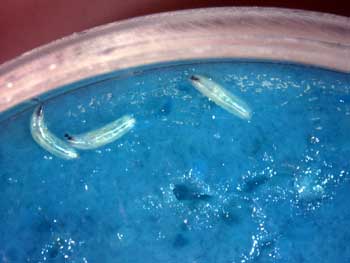
The experiment suggests that bacteria indeed affect the flies’ food choices. Dukas’ team published its findings in April 2014 in The Journal of Experimental Biology.
But why would flies want to eat leftover food? Odd as it might sound, this strategy might protect young flies from deadly parasites such as wasps. Larvae burrow little tunnels into food as they eat. Other larvae that later visit the same food could hide in those tunnels to conceal themselves from wasps. The larvae also could more easily make new tunnels in food that had already been burrowed.
But microbes might do more than guide flies toward food with good hiding spots. Some bacteria in flies produce chemicals that kill mold. Mold can grow on food and harm fruit flies. So the microbes might also help make the leftovers safe for the flies to eat.
Finally, the microbial chemicals might signal to flies that the food is nutritious. After all, those chemicals were left behind by maggots that previously enjoyed the meal. Sniffing the chemicals might be like reading good reviews of a restaurant: The scent tells the fly that the food was quite popular.
Sniffing out a mate
Hitchhiking bacteria can do more than just aid feeding and development. The influence of bacteria also might extend to the creation of new species.
The formation of new species is partly driven by mating choices. For example, take two groups of animals that belong to the same species. Those in one group might begin to mate only with animals from that same group. (This often happens when something isolates one group of some species — such as when a river or mountain emerges in part of the species’ range.) Over time, two isolated groups of a species could each change in unique ways, eventually creating separate species.
But bacteria also can affect mating choices, researchers have shown. That means microbes might also trigger the formation of new species.
A husband-and-wife team in Israel wanted to investigate this possibility. Eugene Rosenberg is a microbiologist at Tel Aviv University. His wife, Ilana Zilber-Rosenberg, is an independent biochemist in Givat Shmuel. The pair came across an old study from the 1980s that offered some clues.
In that study, a scientist had split fruit flies into two groups. She fed one group starch and the other group maltose, a type of sugar. About a year — and many fruit-fly generations later — she found that populations raised on starch now tended to choose other “starch” flies as their mates. And the “maltose” flies were more likely to mate with others sharing their diet.
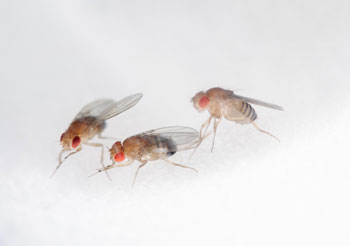
“The first thing to change when you eat something different is microbes,” he explains. For example, microbes in the gut that excel at breaking down the new food might multiply. These new bacteria might change an animal’s scent by producing chemicals. And animals often choose mates based on their scent.
So the Israeli team repeated the experiment, but with a twist. Again, the team split fruit flies into two groups, giving each of them a different diet. One fly group’s food contained molasses and cornmeal. The other group’s food contained starch.
A BUG’S BUGS This brief video highlights the bacteria (shown in pink) in a fruit fly gut. The purple areas are fly cells. Gil Sharon |
The scientists wanted to see how quickly any mating preference emerged. After just a few weeks, they tested pairs of flies. Already, the flies had gone through two generations.
The researchers put a male and female from the molasses group together with a male and female from the starch group. Right away, the flies preferred to mate with others that had been eating their food.
Next, the scientists investigated whether bacteria played a role in this preference. So the team treated the flies with antibiotics to kill their microbes, then repeated the mating tests. This time, the flies mated at random. They no longer preferred to mate with flies raised on the same type of food.
When the researchers isolated microbes from the starch and molasses flies, they found a major difference. Lactobacillus plantarum was a much more common species in the starch flies. This germ is good at breaking down starch.
Fly perfume
But a big question remained: How did bacteria change the scent of the two different groups of fruit flies?
Rosenberg’s team suspected the answer might lie in chemicals called cuticular hydrocarbons (CHCs). These chemicals cover the surface of the fly. A fly’s scent will differ depending on its mix of CHCs. Explains Sharon, it’s as if “each fly has a bouquet of flowers it’s holding.”
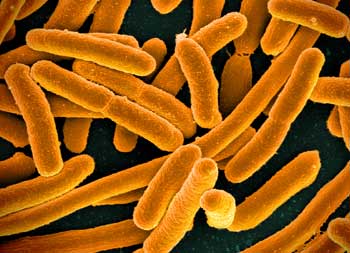
To find out, the researchers used a mutant type of fruit fly that can’t make CHCs. Lacking CHCs, these flies aren’t picky about their mates. They can’t even tell the difference between males and females.
The researchers then concocted some special “perfumes.” They extracted CHCs from the starch flies and others from the molasses flies. Then the team coated mutant flies with the CHCs from starch flies. Those mutant flies now smelled like starch flies. The researchers did the same with CHCs from molasses flies. Then the team repeated the mating tests with the perfumed flies.
The research is not yet complete, and another team in Israel is continuing the work. But early results suggest that flies perfumed with CHCs from starch flies prefer to mate with each other. And flies perfumed with CHCs from molasses flies prefer to mate with others sharing their scent.
Do bacteria affect mating, and the formation of other animal species, too? The answer isn’t clear. But microbes might influence how animals, including humans, choose their mates.
So the next time you look in the mirror, think about the trillions of little travelers that fill your body and cover your skin. They may be invisible. Still, they can affect your life in powerful ways.
